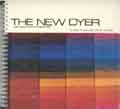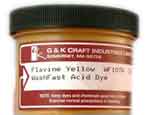how to tone down excessively bright dye colors
Name: Janet
—ADVERTISEMENT—
Vinroot and Crowder'sThe New Dyer

New Dyer With Colorcue Hue Analysis Aide
Washfast Acid dyes
at Paradise Fibers

Washfast Acid dyes
WashFast acid dyes are excellent for use on wool, silk, and nylon.
at Paradise Fibers

Washfast Acid dyes
WashFast acid dyes are excellent for use on wool, silk, and nylon.
Message: My friends use bright, raw colors for dye projects. I want to change the prepared dyes with a dye that would warm, mute these mixed raw colors. I read your FAQ and didn't see any answers that deal with this issue. Thank You!
Any bright pure color can be muted by adding a little bit of its opposite on the color wheel: for a pure magenta, use green; for a pure orangish red, use turquoise; for a pure blue, use orange; for a bright lemon yellow, add purple. (An easy way to find the exact opposite of a color is to stare at the color for one minute, then switch your gaze to a white page; the after-image you see will be the exact complement of the color you were looking at.)
To save time and effort, you can prepare a neutral toning color by mixing dyes together. This can be a neutral grey, or some sort of brown. To prepare any of these neutral colors yourself, you will need to mix each of the three primary colors, which are magenta, cyan, and yellow. It's easier to get a neutral color, using less dye, if you start with the duller primaries, such as navy blue or terracotta orange. Some people like to use black, but be careful with this, as most black dyes are not quite neutral, tending toward green or navy or purple or brown; do a small test, or many small tests, to make sure that you like the results of whatever you try.
If you want to tone down several different colors to use together in a project, it works very well to use the same neutral toning gray or brown on each of them. Using the same toning color with each of them, ideally in the same strength, will cause them all to harmonize together well. You can do this by mixing your neutral toning dye mixture with the dyes before you apply them, or you can pre-dye or after-dye each item with the neutral color as a separate step.
All of the above applies equally well to any class of dye, including acid dyes for wool and fiber reactive dyes for cotton.
The 1981 book, The New Dyer, With Colorcue Hue Analysis Aide
Another way to visualize the effects of mixing different colors, in advance of actually mixing the dyes, is the use Olli Niemitalo's online Dye Mixer Applet. It is a little complicated, but not impossible, to adjust the given colors to make the colors that you have to work with. See my page, "How to translate numbers from the Dye Mixer Applet to grams of dye".
Vinroot and Crowder recommend mixing a combination of 35% yellow plus 25% red plus 40% black to get a gray toner; 70% yellow plus 20% red plus 10 percent blue to get a brown toner; 60% yellow plus 30 percent red plus 10 percent blue to get a coppery brown toner; and 25% yellow plus 25% red plus 50% black to get a dark brown toner. Unfortunately, these figures do not translate directly to grams or teaspoons of dye, since different dyes are of different strengths. It will take some trial and error to mix exactly the colors that you want.
Some types of dyes are available in many different premixed colors, some of which are ideal for toning purposes. For example, Procion MX dyes can be purchased in a huge number of premixed dye colors; they work well on cotton and other cellulose fibers, but will produce different colors when used on protein fibers such as silk and wool. PRO Chemical & Dye's Procion MX dye color, PRO MX Chino, used to be very popular as a warm toner among hand dyers, though it seems to be less popular since changes in the availability of manufactured colors forced a change in the formula. Other browns may be useful as warm toners, and the various grays may be useful as cool toners. 609 Deep Black produces a neutral gray on cotton at any dilution, making it useful when dyeing solid colors. However, it will produce a non-neutral color when used on silk or wool. If you are dyeing wool or silk, consider the wide selection of different pre-mixed colors among the Washfast Acid Dyes sold by PRO Chemical & Dye. Other suppliers that sell the WashFast Acid Dyes provide considerably fewer premixed colors.
(Please help support this web site. Thank you.)
Posted: Friday - March 27, 2009 at 01:27 PM
Follow this blog on twitter here.
Quick Links
- All About Dyes & Dyeing Top -
- Top of this blog -
- FAQ -
- The Dye Forum -
- How to Tie Dye - How to Batik -
- Books - Toys - Plants -
- Top of this blog -
- FAQ -
- The Dye Forum -
- How to Tie Dye - How to Batik -
- Books - Toys - Plants -
More in this category:
- -
Statistics
Total entries in this blog:
Total entries in this category:
Published On: Aug 29, 2012 02:48 PM
Total entries in this category:
Published On: Aug 29, 2012 02:48 PM